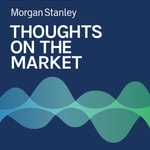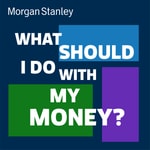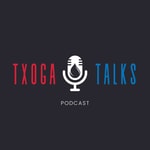Thoughts on the Market – Details, episodes & analysis
Podcast details
Technical and general information from the podcast's RSS feed.

Thoughts on the Market
Morgan Stanley
Frequency: 1 episode/2d. Total Eps: 1421

Short, thoughtful and regular takes on recent events in the markets from a variety of perspectives and voices within Morgan Stanley.
Recent rankings
Latest chart positions across Apple Podcasts and Spotify rankings.
Apple Podcasts
🇨🇦 Canada - investing
26/07/2025#55🇬🇧 Great Britain - investing
26/07/2025#21🇬🇧 Great Britain - business
26/07/2025#68🇩🇪 Germany - investing
26/07/2025#80🇺🇸 USA - investing
26/07/2025#21🇺🇸 USA - business
26/07/2025#86🇫🇷 France - investing
26/07/2025#46🇨🇦 Canada - investing
25/07/2025#47🇬🇧 Great Britain - investing
25/07/2025#22🇬🇧 Great Britain - business
25/07/2025#70
Spotify
🇬🇧 Great Britain - business
17/07/2025#50→🇬🇧 Great Britain - business
16/07/2025#50↗🇬🇧 Great Britain - business
11/07/2025#50↗🇬🇧 Great Britain - business
07/07/2025#49↗🇬🇧 Great Britain - business
05/07/2025#49↗🇬🇧 Great Britain - business
04/07/2025#50↘🇬🇧 Great Britain - business
03/07/2025#49↗🇬🇧 Great Britain - business
02/07/2025#50↗🇬🇧 Great Britain - business
27/06/2025#50↘🇬🇧 Great Britain - business
26/06/2025#48↘
Shared links between episodes and podcasts
Links found in episode descriptions and other podcasts that share them.
See allRSS feed quality and score
Technical evaluation of the podcast's RSS feed quality and structure.
See allScore global : 63%
Publication history
Monthly episode publishing history over the past years.
Special Encore: Health Care for Longer, Healthier Lives
Episode 1202
vendredi 30 août 2024 • Duration 04:04
Original Release Date August 8, 2024: Our Head of Europe Sustainability Research discusses how rising longevity is revolutionizing our fundamental approach from reactive to proactive treatment.
----- Transcript -----
Welcome to Thoughts on the Market. I’m Mike Canfield, Morgan Stanley’s European Head of Sustainability Research. Along with my colleagues, we’re bringing you a variety of perspectives; and today we’re focusing on a topic that affects everyone – how much does poor health cost us? And how are ageing populations and longer life expectancy driving a fundamental shift in healthcare?
It’s Thursday, August the 8th, at 4pm in London.
As populations age across the developed world, health systems need to help people live both longer and healthier. The current system is typically built around to focus on acute conditions and it’s more reactive; so it introduces clinical care or drugs to respond to a condition after it’s already arisen, rather than keeping people healthy in the first instance. So increasingly, with the burden of chronic disease becoming by far the greatest health and economic challenge we face, we need to change the structure of the healthcare system.
Essentially, the key question is how much is poor health amongst the ageing population really costing society? To get a true sense of that, we need to keep in mind that workers over 50 already earn one out of every three dollars across the G20 regions. By 2035, they're projected to generate nearly 40 per cent of all household income. So with that in mind, preventable conditions amongst those people aged 50-64 at the moment, are already costing G20 economies over $1 trillion annually in productivity loss. And there’s one more key number: 19 per cent. That's how much age-diverse workforces can raise GDP per capita over the next thirty years, according to estimates from the Organization for Economic Co-operation and Development, or OECD. So clearly, keeping workers healthier for longer underpins a more productive, more efficient, and a profitable global economy. So it’s clear that [if] the current healthcare system were to shift from sick from care to prevention, the global gains would be substantial.
The BioPharma sector is already contributing some targeted novel treatments in areas like smart chemotherapy and in CRISPR – which is a technology that allows for selective DNA modification. While we can credit BioPharma and MedTech for really powerful innovations in diagnostics, in AI deployment for areas like data science and material science, and in sophisticated telemedicine – all these breakthroughs together give a more personalized, targeted health system; which is a big step in the right direction, but honestly they alone can’t solve this much broader longevity challenge we face.
Focus on health and prevention, ultimately, could address those underlying causes of ill-health, so that problems don’t arise even in the first instance. Governments around the world are obviously realizing the value of preventive care over sick care. And as a strategy, disease prevention fundamentally aims to promote wellness across the board, whether that’s in things like mental state, nutrition or even in things like sleep and stress. While it might be easy to kind of conflate that with wellness trends – things like green smoothies or meditation – the underlying benefits of boosting health at the cellular level have much broader and deeper implications. Things like Type 2 diabetes and heart disease, supporting better health across populations can significantly reduce the incidence of a wide range of chronic conditions. It can lower the burden on health systems overall, and actually increase healthy lifespan at the end of the day.
BioPharma advances are significant, but addressing longevity will require a much broader alignment across a myriad of elements; everything really from the food system to sanitation to training healthcare professionals. And of course, all of that will require consistent policy support. Regulators and policymakers are paying very close attention to their ageing population – and so are we. We’ll continue to bring you updates on this topic, which is so important to all of us.
Thanks for listening. If you enjoy the show, please do leave us a review wherever you listen and share Thoughts on the Market with a friend or colleague today.
Is the Fed Behind the Curve?
Episode 1200
jeudi 29 août 2024 • Duration 11:56
As the US Federal Reserve mulls a forthcoming interest rate cut, our Head of Corporate Credit Research and Global Chief Economist discuss how it is balancing inflationary risks with risks to growth.
----- Transcript -----
Andrew Sheets: Welcome to Thoughts on the Market. I'm Andrew Sheets, Head of Corporate Credit Research at Morgan Stanley.
Seth Carpenter: And I'm Seth Carpenter, Morgan Stanley’s Global Chief Economist.
Andrew Sheets: And today on the podcast, we'll be discussing the Federal Reserve, whether its policy is behind the curve and what's next.
It's Thursday, August 29th at 2pm in London.
Seth Carpenter: And it's 9am in New York.
Andrew Sheets: Seth, it's always great to talk to you. But that's especially true right now. The Federal Reserve has been front and center in the markets debate over the last month; and I think investors have honestly really gone back and forth about whether interest rates are in line or out of line with the economy. And I was hoping to cover a few big questions about Fed policy that have been coming up with our clients and how you think the Fed thinks about them.
And I think this timing is also great because the Federal Reserve has recently had a major policy conference in Jackson Hole, Wyoming where you often see the Fed talking about some of its longer-term views and we can get your latest takeaways from that.
Seth Carpenter: Yeah, that sounds great, Andrew. Clearly these are some of the key topics in markets right now.
Andrew Sheets: Perfect. So, let's dive right into it. I think one of the debates investors have been having -- one of the uncertainties -- is that the Fed has been describing the risk to their outlook as balanced between the risk to growth and risk to inflation. And yet, I think for investors, the view over the last month or two is these risks aren't balanced; that inflation seems well under control and is coming down rapidly. And yet growth looks kind of weak and might be more of a risk going forward.
So why do you think the Fed has had this framing? And do you think this framing is still correct in the aftermath of Jackson Hole?
Seth Carpenter: My personal view is that what we got out of Jackson hole was not a watershed moment. It was not a change in view. It was an evolution, a continuation in how the Fed's been thinking about things. But let me unpack a few things here.
First, markets tend to look at recent data and try to look forward, try to look around the corner, try to extrapolate what's going on. You know as well as I do that just a couple weeks ago, everyone in markets was wondering are we already in recession or not -- and now that view has come back. The Fed, in contrast, tends to be a bit more inertial in their thinking. Their thoughts evolve more slowly, they wait to collect more data before they have a view. So, part of the difference in mindset between the Fed and markets is that difference in frequency with which updates are made.
I'd say the other point that's critical here is the starting point. So, the two risks: risks to inflation, risks to growth. We remember the inflation data we're getting in Q1. That surprised us, surprised the market, and it surprised the Fed to the upside. And the question really did have to come into the Fed's mind -- have we hit a patch where inflation is just stubbornly sticky to the upside, and it's going to take a lot more cost to bring that inflation down. So those risks were clearly much bigger in the Fed’s mind than what was going on with growth.
Because coming out of last year and for the first half of this year, not only would the Fed have said that the US economy is doing just fine; they would have said growth is actually too fast to be consistent with the long run, potential growth of the US economy. Or reaching their 2 per cent inflation target on a sustained basis. So, as we got through this year, inflation data got better and better and better, and that risk diminished.
Now, as you pointed out, the risk on growth started to rise a little bit. We went from clearly growing too fast by some metrics to now some questions -- are we softened so much that we're now in the sweet spot? Or is there a risk that we're slowing too much and going into recession?
But that's the sense in which there's balance. We went from far higher risks on inflation. Those have come down to, you know, much more nuanced risks on inflation and some rising risk from a really strong starting point on growth.
Andrew Sheets: So, Seth, that kind of leads to my second question that we've been getting from investors, which is, you know, some form of the following. Even if these risks between inflation and growth are balanced, isn't Fed policy very restrictive? The Fed funds rate is still relatively high, relative to where the Fed thinks the rate will average over the long run. How do you think the Fed thinks about the restrictiveness of current policy? And how does that relate to what you expect going forward?
Seth Carpenter: So first, and we've heard this from some of the Fed speakers, there's a range of views on how restrictive policy is. But I think all of them would say policy is at least to some degree restrictive right now. Some thinking it's very restrictive. Some thinking only modestly.
But when they talk about the restrictiveness of policy in the context of the balance of these risks, they're thinking about the risks -- not just where we are right now and where policy is right now; but given how they're thinking about the evolution of policy over the next year or two. And remember, they all think they're going to be cutting rates this year and all through next year.
Then the question is, over that time horizon with policy easing, do we think the risks are still balanced? And I think that's the sense in which they're using the balance of risks. And so, they do think policy is restrictive.
They would also say that if policy weren't restrictive, [there would] probably be higher risks to inflation because that's part of what's bringing inflation out of the system is the restrictive stance of policy. But as they ease policy over time, that is part of what is balancing the risks between the two.
Andrew Sheets: And that actually leads nicely to the third question that we've been getting a lot of, which is again related to investor concerns -- that maybe policy is moving out of line with the economy. And that's some form of the following: that by even just staying on hold, by not doing anything, keeping the Fed funds rate constant, as inflation comes down, that rate becomes higher relative to inflation. The real policy rate rises. And so that represents more restrictive monetary policy at the very moment, when some of the growth data seems to be decelerating, which would seem to be suboptimal.
So, do you think that's the Fed's intention? Do you think that's a fair framing of kind of the real policy rate and that it's getting more restrictive? And again, how do you think the Fed is thinking about those dynamics as they unfold?
Seth Carpenter: I do think that's an important framing to think -- not just about the nominal level of interest rates; you know where the policy rate is itself, but that inflation adjusted rate. As you said, the real rate matters a lot. And inside the Fed as an institution there, that's basically how most of the people there think about it as well. And further, I would say that very framing you put out about -- as inflation falls, will policy become more restrictive if no adjustment is made? We've heard over the past couple of years, Federal Reserve policymakers make exactly that same framing.
So, it's clearly a relevant question. It's clearly on point right now. My view though, as an economist, is that what's more important than realized inflation, what prices have done over the past 12 months. What really matters is inflation expectations, right? Because if what we're trying to think about is -- how are businesses thinking about their cost of capital relative to the revenues are going to get in the future; it's not about what policy, it's not about what inflation did in the past. It's what they expect in the future.
And I have to say, from my perspective, inflation expectations have already fallen. So, all of this passive tightening that you're describing, it's already baked in. It's already part of why, in my view, you know, the economy is starting to slow down. So, it's a relevant question; but I'm personally less convinced that the fall in inflation we've seen over the past couple of months is really doing that much to tighten the stance of policy.
Andrew Sheets: So, Seth, you know, bringing this all together, both your answers to these questions that are at the forefront of investors' minds, what we heard at the Jackson Hole Policy Conference and what we've heard from the latest FOMC minutes -- what does Morgan Stanley Economics think the Fed's policy path going forward is going to be?
Seth Carpenter: Yeah. So, you know, it's funny. I always have to separate in my brain what I think should happen with policy -- and that used to be my job. But now we're talking about what I think will happen with policy. And our view is the Fed's about to start cutting interest rates.
The market believes that now. The Fed seems from their communication to believe that. We've got written down a path of 25 basis point reduction in the policy rate in September, in November, in December. So, a string of these going all the way through to the middle of next year to really ease the stance of policy, to get away from being extremely restrictive, to being at best only moderately restrictive -- to try to extend this cycle.
I will say though, that if we're wrong, and if the economy is a bit slower than we think, a 50 basis point cut has to be possible.
And so let me turn the tables on you, Andrew, because we're expecting that string of 25 basis point cuts, but the market is pricing in about 100 basis points of cuts this year with only three meetings left. So that has to imply at least one of those meetings having a 50 basis point cut somewhere.
So, is that a good thing? Would the market see a 50 basis point cut as the Fed catching up from being behind the curve? Or would the market worry that a bigger cut implies a greater recession risk that could spook risk assets?
Andrew Sheets: Yeah, Seth, I think that's a great question because it's also one where I think views across investors in the market genuinely diverge. So, you know, I'll give you our view and others might have a different take.
But I think what you have is a really interesting dynamic where kind of two things can be true. You know, on the one hand, I think if you talk to 50 investors and ask them, you know, would they rather for equities or credit have lower rates or higher rates, all else equal -- I think probably 50 would tell you they would rather have lower rates.
And yet I think if you look back at history, and you look at the periods where the Federal Reserve has been cutting rates the most and cutting most aggressively, those have been some of the worst environments for credit and equities in the modern era. Things like 2001, 2008, you know, kind of February of 2020. And I think the reason for that is that the economic backdrop -- while the Fed is cutting -- matters enormously for how the market interprets it.
And so, conditions where growth is weakening rapidly, and the Fed is cutting a lot to respond to that, are generally periods that the market does not like. Because they see the weaker data right now. They see the weakness that could affect earnings and credit quality immediately. And the help from those lower rates because policy works with lag may not arrive for six or nine or twelve months. It's a long time to wait for the cavalry.
And so, you know, the way that we think about that is that it's really, I think the growth environment that’s going to determine how markets view this rate cutting balance. And I think if we see better growth and somewhat fewer rate cuts, the base case that you and your team at Morgan Stanley Economics have -- which is a bit fewer cuts than the market, but growth holding up -- which we think is a very good combination for credit. A scenario where growth is weaker than expected and the Fed cuts more aggressively, I think history would suggest, that's more unfriendly and something we should be more worried about.
So, I do think the growth data remains extremely important here. I think that's what the market will focus most on and I think it's a very much good is good regime that I think is going to determine how the market views cuts. And fewer is fine as long as the data holds up.
Seth Carpenter: That make a lot of sense, and thanks for letting me turn the tables on you and ask questions. And for the listeners, thank you for listening. If you enjoy this show, leave us a review wherever you listen to podcast. And share Thoughts on the Market with a friend or a colleague today.
Strong Balance Sheets, Cautious Boardrooms
Episode 1191
vendredi 16 août 2024 • Duration 03:52
Our Head of Corporate Credit Research explains how corporate balance sheets have remained resilient post-COVID, and why that could continue in the face of a potential economic slowdown.
----- Transcript -----
Welcome to Thoughts on the Market. I'm Andrew Sheets, head of Corporate Credit Research at Morgan Stanley. Along with my colleagues bringing you a variety of perspectives, today I'll discuss how corporate balance sheets are in a better place to handle a potential growth slowdown.
It's Friday, August 16th at 2pm in London.
Much of the volatility over the last several weeks has been centered around fears that excessively high interest rates from the Federal Reserve will now cause the US economy to slow too quickly. Morgan Stanley’s economists are more optimistic and believe that the data will hold up, leading the Fed to start a gradual rate cutting cycle in September, rather than a more radical course-correction. Against this backdrop, good economic data is good for markets and vice versa.
But even though we remain optimistic at Morgan Stanley about a soft landing in the US economy, our economists still expect growth to slow. How prepared are corporate balance sheets for that slowing, and how worried should we be that this could lead to higher rates of default?
A good place to start is thinking about how optimistic companies were heading into any slowdown of the economy. Overconfidence is often the enemy of credit investors, as rose-tinted glasses can lead companies to make too many unwise acquisitions or investments, funded with too much debt.
Yet across a variety of metrics, this isn’t what we see. Despite some of the lowest interest rates in human history, the level of debt to cash-flow for US and European companies has been pretty stable over the last five years. Excess capital held by banks remains historically high. And Merger and Acquisition activity, another key measure of corporate confidence, remains well below the long run trend – even after a pick up this year, as my colleague Ariana Salvatore discussed on this program earlier in the week.
So, despite the strong recovery in the US economy and the stock market over the last four years, many corporate boardrooms have remained cautious, a good thing when considering their financial risk.
Where Corporate debt did increase, it was often in places that we think could withstand it. Large-cap Technology and Pharmaceuticals issuers have taken out more debt over the last several years, relative to history, but it's been a pretty modest amount from a pretty low historical starting point. The Utility sector has also taken on more debt recently, but the stable nature of its business may make this easier to handle.
While companies across the ratings spectrum generally didn’t increase their leverage over the last several years, they did take advantage of refinancing the debt they already had at historically low rates. And this is important for thinking about the stress that higher interest rates could eventually produce.
The average maturity in the US Investment Grade index is about 11 years, and that means that, for many companies, potentially less than one-tenth of their overall debt resets to the current interest rate every year. That means companies may still have many years of enjoying the low interest rates of the past, and that helps smooth the adjustment to higher interest rates in the future.
The lack of corporate confidence since COVID means that corporate balance sheets are generally in a better place if the economy potentially slows. But while this is helpful overall, it’s important to note that it doesn’t apply in all cases. We still see plenty of dispersion between winners and losers, driving divergence under the hood of the credit market. Even if balance sheets are stronger overall, there is plenty of opportunity to pick your spots.
Thanks for listening. If you enjoy the show, leave us a review wherever you listen and share Thoughts on the Market with a friend or colleague today.
2024 US Elections: Inflation’s Possible Paths
Episode 1099
mercredi 10 avril 2024 • Duration 11:16
Our Global Chief Economist joins our Head of Fixed Income Research to review the most recent Consumer Price Index data, and they lay out potential outcomes in the upcoming U.S. elections that could impact the course of inflation’s trajectory.
----- Transcript -----
Michael Zezas: Welcome to Thoughts on the Market. I'm Michael Zezas, Morgan Stanley's Global Head of Fixed Income and Thematic Research.
Seth Carpenter: And I'm Seth Carpenter, Global Chief Economist.
Michael Zezas: And on this special episode of Thoughts on the Market, we'll be taking a look at how the 2024 elections could impact the outlook for inflation.
It's Wednesday, April 10th at 4pm in New York.
Seth, earlier this morning, the US Bureau of Labor Statistics released the Consumer Price Index (CPI) data for March, and it's probably an understatement to say it's been a much-anticipated report -- because it gives us some signal into both the pace of inflation and any potential fed rate cut path for 2024. I want to get into the longer-term picture around what the upcoming US election could mean for inflation. But first, I'd love your immediate take on this morning's data.
Seth Carpenter: Absolutely, Mike. This morning's CPI data were absolutely critical. You are right. Much anticipated by markets. Everyone looking for a read through from those data to what it means for the Fed. I think there's no two ways about it. The market saw the stronger than expected inflation data as reducing the likelihood that the Fed would start cutting rates in June.
June was our baseline for when the Fed would start cutting rates. And I think we are going to have to sharpen our pencils and ask just how much is this going to make the Fed want to wait? I think over time, however, we still see inflation drifting down over the course of this year and into next year, and so we still think the Fed will get a few rate hikes in.
But you wanted to talk longer term, you wanted to talk about elections. And when I think about how elections could affect inflation, it's usually through fiscal policy. Through choices by the President and the Congress to raise taxes or lower taxes, and by choices by the Congress and the President to increase or decrease spending.
So, when you think about this upcoming election, what are the main scenarios that you see for fiscal policy and an expansion, perhaps, of the deficit?
Michael Zezas: Yeah, I think it's important to understand first that the type of election outcome that historically has catalyzed a deficit expansion is one where one party gets complete control of both the White House and both chambers of Congress.
In 2025, what we think this would manifest in if the Democrats had won, is kind of a mix of tax extensions, as well as some spending items that they weren't able to complete during Biden's first term -- probably somewhat offset by some tax increases. On net, we think that would be incremental about $500 billion over 10 years, or maybe $40 [billion] to $50 billion in the first year.
If Republicans are in a position of control, then we think you're looking at an extension of most of the expiring corporate tax cuts -- expire at the end of 2025 -- that is up to somewhere around a trillion dollars spread over 10 years, or maybe a hundred to $150 billion in the first year.
Seth Carpenter: So, what I'm hearing you say is a wide range of possible outcomes, because you didn't even touch on what might happen if you've got a split government, so even smaller fiscal expansion.
So, when I take that range from a truly modest expansion, if at all, with a split government, to a slight expansion from the Democrats, a slightly bigger one from a Republican sweep, I'm hearing numbers that clearly directionally should lead to some inflationary pressures -- but I'm not really sure they're big enough to really start to move the needle in terms of inflationary outcomes.
And I guess the other part that we have to keep in mind is the election’s happening in November of this year. The new president, if there's a new president, the new Congress would take seats in the beginning of the year next year. And so, there's always a bit of a lag between when a new government takes control and when legislation gets passed; and then there's another lag between the legislation and the outcome on the economy.
And by the time we get to call it the end of 2025 or the beginning of 2026, I think we really will have seen a lot of dissipation of the inflation that we have now. So, it doesn't really sound like, at least from those baseline scenarios that we're talking about a huge impetus for inflation. Would you think that's fair?
Michael Zezas: I think that's fair. And then it sort of begs the question of, if not from fiscal policy, is there something we need to consider around monetary policy? And so around the Fed, Chair Powell's term ends in January of 2026 -- meaning potential for a new Fed chair, depending on the next US president.
So, Seth, what do you think the election could mean for monetary policy then?
Seth Carpenter: Yeah, that's a great question, Mike. And it's one that, as you know well, we tend to get from clients, which is why you and I jointly put out some research with other colleagues on just what scope is there for there to be a -- call it particularly accommodative Fed chair under that Republican sweep scenario.
I would say my take is -- not the biggest risk to worry about right now. There are two seats on the Federal Reserve Board that are going to come open for whoever wins the election as president to appoint. That's the chair, clearly very important. And then one of the members of the Board of Governors.
But it's critical to remember there's a whole committee. So, there are seven members of the Board of Governors plus five voting members, across the Federal Reserve Bank presidents. And to get a change in policy that is so big, that would have massive inflationary impacts, I really think you'd have to have the whole committee on board. And I just don't see that happening.
The Fed is set up institutionally to try to insulate from exactly that sort of, political influence. So, I don't think we would ever get a Fed that would simply rubber stamp any president's desire for monetary policy.
Michael Zezas: I think that makes a lot of sense. And then clients tend to ask about two other concerns; with particularly concerns with the Republican sweep scenario, which would be the impact of potentially higher trade tariffs and restrictions on immigration. What's your read here in terms of whether or not either of these are reliable in terms of their impact on inflation?
Seth Carpenter: Yeah, super topical. And I would say at the very least, we have some experience now with tariff policy. And what did we see during the last episode where there was the trade war with China? I think it's very natural to assume that higher tariffs mean that the cost of imported goods are going to be higher, which would lead to higher inflation; and to some extent that was true, but it was a much smaller, much more muted effect than I think you might otherwise assume given numbers like 25 per cent tariffs or has been kicked around a few times, maybe 60 per cent tariffs. And the reason for that change is a few things.
One, not all of the goods being brought in under tariffs are final consumer goods where the price would just go straight through to something like the CPI. A lot of them were intermediate goods. And so, what we saw in the last round of tariffs was some disruption to US manufacturing, disruption to production in the United States because the cost of production went up.
And so, it was as much a supply shock as it was anything else. For those final consumer goods, you could see some pass through; but remember, there's also the offset through the exchange rate, that matters a lot. And, consumers, they have a willingness to pay, or maybe a willingness not to pay, and so, sellers aren't always able to pass through the full cost of the tariffs. And so, as a result, I think the net effect there is some modestly higher inflation, but really, it's important to keep in mind that hit to economic activity that, over time, could actually go in the opposite direction and be disinflationary.
Immigration, very different story, and it has been very much in the news recently. And we have seen a huge surge in immigration last year. We expect it to continue this year. And we think it's contributing to the faster run rate that we've seen in the economy without continued inflationary pressure. So, I think it's a natural question to ask -- if immigration was restricted, would we see labor shortages? Would that drive up inflation? And the answer is maybe.
However, a few things are really critical. One, the Fed is still in restrictive territory now, and they're only going to start to lower rates if and when we see inflation come down. So the starting point will matter a lot. And second, when we did our projections, we took a lot of input from where the CBO's estimates are, and they've already been assuming that immigration flows really start to normalize a bit in 2025 and a lot more in 2026. Back to run rates that are more like pre-COVID rates. And so, against that backdrop, I think a change in immigration policy might be less inflationary because we'd already be in a situation where those flows were coming down.
But that's a good time for me to turn things around, Mike, and throw it right back to you. So, you've been thinking about the elections. You run thematic research here. I've heard you say to clients more than once that there is some scope, but limited scope for macro markets to think about the outcome from the election, but lots of scope from a micro perspective. So, if we were thinking about the effect of the election on equity markets, on individual sectors, what would be your early read on where we should be focusing most?
Michael Zezas: So we've long been saying that the reliable market impacts from this election, at least this far out, appear to be more micro than macro. And so, for example, in a Republican sweep scenario, we feel pretty confident that there would be a heavier skew towards extending corporate tax cut provisions that are expiring at the end of 2025.
And if you look at who benefits fundamentally from those extensions, it tends to be companies that do more business domestically in the US and tend to be a bit smaller. Sectors that tend to come in the scope include industrials and telecom; and in terms of size of company, it tends to skew more towards small caps.
Seth Carpenter: So, I can see that, Mike, but let me make it even more provocative because a question I have got from clients recently is the Inflation Reduction Act (IRA), which in lots of ways is helping to spur spending on infrastructure, is helping to spur spending on green energy transition. What's the chance that that gets repealed if the outcome, if the election goes to Trump?
Michael Zezas: We see the prospects for the IRA to get repealed is quite limited, even in a Republican sweep scenario. The challenge for folks who might not want to see the law exist anymore is that many of the benefits of this law have already been committed; and the geographic area where they've been committed overlays with many of the districts represented by Republicans, who would have to vote for its repeal. And so, they might be voting against the interests of their districts to do that. So, we think this policy is a lot stickier than people perceive. The campaign rhetoric will probably be, pretty elevated around the idea of repealing it; but ultimately, we think most of the money behind the IRA will be quite durable. And this is something that should accrue positively to the clean tech sector in particular.
Seth Carpenter: Got it. Well, Mike, as always, I love being able to take time and talk to you.
Michael Zezas: Seth, likewise, thanks for taking the time to talk. And as a reminder, if you enjoy Thoughts on the Market, please take a moment to rate and review us on the Apple podcast app. It helps more people find the show.
Michael Zezas: States Look to D.C. to Fill Budget Holes
Episode 196
mercredi 22 juillet 2020 • Duration 02:17
Local and state governments across the U.S. are eagerly watching whether a new round of stimulus will help them address budget shortfalls. Will Congress deliver?
Mike Wilson: Adapting to The Ninth Wonder of the World
Episode 195
lundi 20 juillet 2020 • Duration 04:17
Understanding the regime of financial repression we are under, and recent changes in it, is key for successful investment. Chief Investment Officer, Mike Wilson explains.
Andrew Sheets: Bracing for Challenges Ahead
Episode 194
vendredi 17 juillet 2020 • Duration 03:07
While July contains a number of potentially positive market events, August and September could present a number of potentially problematic ones.
Michael Zezas: Coronavirus - Why Another Stimulus Deal is Likely
Episode 193
mercredi 15 juillet 2020 • Duration 02:33
Could a new $1 trillion stimulus deal make its way through the halls of Congress before the summer recess? Why the likelihood of a deal is increasing.
Mike Wilson: U.S. Markets Weigh Optimism; Uncertainty
Episode 192
lundi 13 juillet 2020 • Duration 04:02
U.S. equities—tech stocks in particular—have powered higher since March lows, but investors are still parsing Q2 earnings, a coming election and rising COVID-19 cases.
Andrew Sheets: Pressure Testing the “Overoptimistic Markets” Argument
Episode 191
vendredi 10 juillet 2020 • Duration 03:15
The sharp rebound in stock and corporate bond markets has made some question if markets are a bit too upbeat about a speedy recovery. There’s just one problem with this view.







